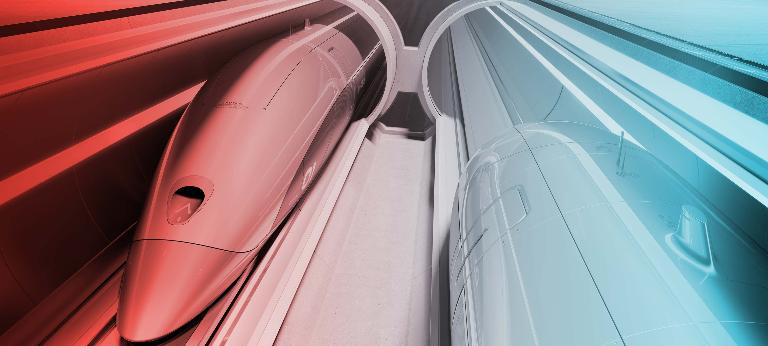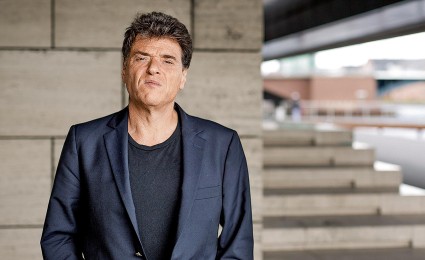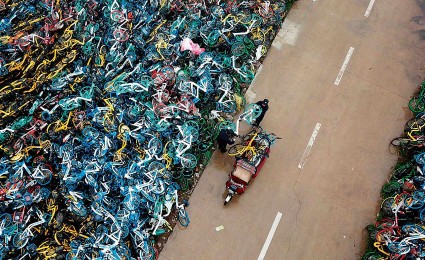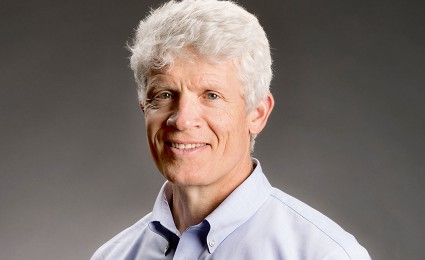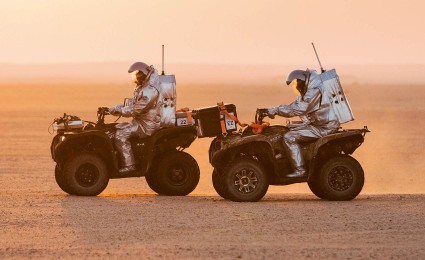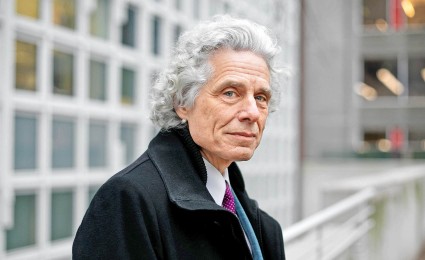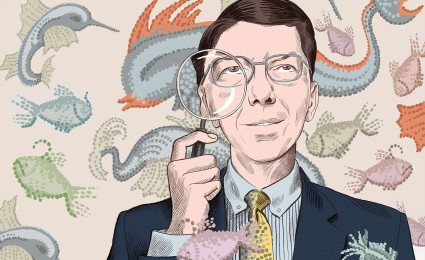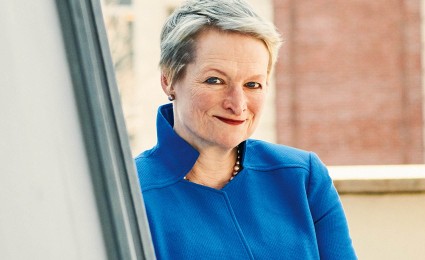Advancements in communications are accelerating Hyperloop development. Think:Art reports on the in-house and crowdsourced efforts leading the vacuum train race.


Think:Act magazine "Own the future"
Hyperloop is shaking up more than transportation

Think:Act Magazine
Hyperloop Transportation Technologies’ Bibop Gresta is innovating with crowdsourcing
As superspeed vacuum trains race ever closer to becoming a reality, Hyperloop Transportation Technology's Bibop Gresta speaks to Think:Act about something that could prove just as revolutionary: the crowdsourcing model that's driving his company's innovations.
Bibop Gresta, chairman of Hyperloop Transportation Technologies (HTT), has an industrial revolution in his sights. He wants to develop a new system of transportation that will boast speeds that haven't been seen since the days of the Concorde. Gresta, who co-founded HTT in 2013 alongside CEO Dirk Ahlborn, believes they have hit upon a new company format. It is capable of responding instantly to emerging problems – or in HTT's case, what might be better described as a global opportunity – securing both the resources and the expertise in partnership with a range of stakeholders and collaborating to meet even far-fetched objectives.
Gresta sees a time in the future when the traditional system of hiring, firing and nine-to-five will be something we see as anachronistic. Instead, he says, people will lend their time and brainpower to projects that trigger their passions. They won't be employees; they will be more like partners. When HTT proves its technology – full-scale passenger pods fired through sealed tubes over vast distances at the speed of sound – it will license its intellectual property to other organizations and won't construct the commercial transport networks itself. He wants other companies to borrow from HTT's structure and methodologies, either wholly or in part, to build on and improve. This, from a seasoned entrepreneur who before the hyperloop had been involved in dozens of businesses in the traditional format, from startups to listed multinationals.
In this interview, Gresta describes his journey from skeptic to evangelist on more than one front. While HTT is not the only company racing to sign up governments and private sector partners to back the hyperloop, it's the only one crowdsourcing its expertise and relying on sophisticated project management and communications platforms to combine the efforts of more than 800 disparate stakeholders. This is the story of a business succeeding, even when 50% of the founders initially thought it couldn’t be done.
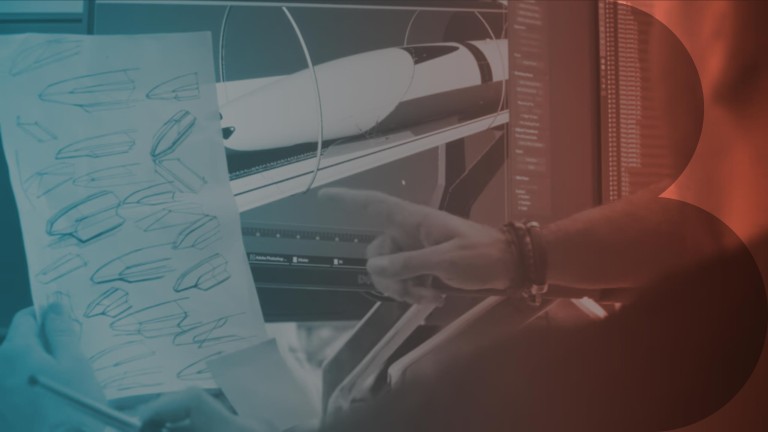
How would you sum up Hyperloop Transportation Technology's progress to date?
Six years ago, Elon Musk published his white paper proposing the hyperloop, a new form of transportation that is fast, convenient and energy-efficient. Now we are nearly ready to demonstrate a full-scale track at our installation in Toulouse, France. This is a four-meter diameter tube and the capsule is 32 meters long, with capacity for 30 passengers inside. This year will see the initial phase of testing and we are working on certification because we want our hyperloop to be implemented in just a few years, not a few decades. So we need to work on practical necessities such as insurance as well as the tech. It means we can build a hyperloop simply and efficiently using disruptive technology, but also move towards commercialization. We have signed three commercial lines in three key places: Abu Dhabi, Ukraine and China.
"We have the knowledge and technology to come together and focus on social responsibility, not just the profits."
Moving from the research and development phase into the implementation phase, we are now talking to a host of governments about commercial hyperloops. I'm very proud of how we have built the company. We did it by asking people to help us answer the toughest questions and, in return, giving them a piece of the company. Today there are 840 experts from a range of backgrounds working with us. It is the biggest crowdsourcing experiment on the planet, involving more than 50 of the top companies in the world. We have raised more than $50 million in cash and $100 million in assets. This is how we have achieved our milestones in a short space of time.
The fundamental science behind the hyperloop has been the subject of experiments for centuries. Why, in 2013, did you think it was the right time to take it seriously?
Even though the fundamentals were in place, the R&D requirements were huge, the equivalent of millions and millions of dollars. Plus, there was no guarantee of success. The difference in 2013 – and ever since – is that the world is hyperconnected. You can give a worldwide call to action and humanity can come together to overcome even the toughest challenges. We had the technology, but more importantly the willingness to unite. It's an unprecedented market condition in which we can tap into global knowledge. Elon Musk's white paper was just a suggestion, but it was also a very inspiring call to action which triggered the imagination of a lot of people. Because so many people were able to talk about it, solutions to problems came quickly.
Why did you think the crowdsourcing model was a risk worth taking? What does it take to coordinate a collaboration on such a mass scale?
When I met my co-founder Dirk Ahlborn, he was already working on the white paper. I had 20 years' experience in 60 startups and as a board member of three listed companies, so I thought I knew everything. I was skeptical of his plan to build a megastructure using crowdsourcing. I thought he was delusional, but he showed me a document showing that 100 scientists from all sorts of companies were already collaborating, all working for the passion of it.
Now we have 420 groups divided between 42 countries and they form the core of the hyperloop R&D. We have an artificial intelligence platform which keeps track of all the conversations as the work develops, as well as a giant project management system that we developed in-house. We put together methodologies that created a unique environment that can be completely administered online. It's not particularly complicated and it works well. We have a system called "Lucy" which was supplied by Facebook. It contacts every member of every team each Monday and asks them to input their hours and the progress they have made. You can ask questions and find experts to help remove roadblocks. It's a mix of human and artificial intelligence that helps us coordinate the teams. The rest is done by our integration team, which checks the validity of the technology and decides what to implement and how.

What has proven a bigger challenge: constructing a working hyperloop or securing agreements with governments and dealing with the bureaucracy or creating a brand new form of transport?
Of course there are a lot of challenges regarding regulation because it is a big change and a lot of new infrastructure, but we are no longer the crazy guys talking about science fiction. It was a lot for national governments to digest. But when they saw the planning and the skilled engineering we could deliver, it persuaded a lot of them, especially when they came to see the working technology at our test site in Toulouse.
In the long term we don't want to construct or implement anything. We will be a large R&D company and we'll license the technology to the private sector locally. Private companies will create and operate the hyperloops around the world. The model will work because hyperloops will make money for the companies that run them, which is a rare thing for transportation systems like rail networks. They won't need a government subsidy. The dozens of companies that have provided assets are now candidates to build the hyperloops. We retain the IP but they commercialize it across industries, not just within the hyperloop project. When we started, people were laughing and they didn't believe we could achieve what we have done. But now, they don't question the how, only the when.
At age 15, Bibop Gresta became director of software development for Alpha Center International in Italy, later founding TV production and distribution company Bibop S.p.A before going on to co-found a successful startup incubator and joining the boards of listed businesses in the UK and Germany. In 2013, he co-founded Hyperloop Transportation Technologies after reading the white paper on the transportation technology by Tesla CEO Elon Musk.
In terms of leadership, what challenges does your model present?
In a way we created a completely new kind of premise. Traditionally, people work for you because you pay them. In this new environment you have a different relationship with your "employees," because they are your partners and stakeholders. The culture was challenging in the beginning but it gave us an unfair advantage. It's incredible to see the amount of commitment and enthusiasm. It's not like hiring and managing people in the normal way. In the future people will share their time across multiple projects, companies and industries. It will be more efficient and more beneficial than the eight-hour behind-a-desk model. In the crowdsourcing model, people only work the hours they need to, so they are really efficient. This model is not just for the hyperloop, it is a new generation of company that will change the way we develop and progress humanity.
You have compared yourself to Janus, the mythical creature with two faces – one looking to the future and one to the past. Why do you identify with that?
When we started, we couldn't hire a hyperloop expert – because they didn't exist – so we had to build a knowledge base. We attracted a mix of retired scientists and young PhDs, on one side looking at the lessons of the past and the other thinking of the future and how we can improve it. The former is NASA, the latter is SpaceX. We mix the two approaches for the best results and it’s working well.
What has been your greatest error and how did you overcome it?
I think it was paying too much attention to what the other companies were doing. We were the first in the market, so when [Virgin] Hyperloop One came along they were aggressive. In the beginning, we were very reactive and that was a mistake. When we stopped reacting to the media and began focusing only on the technology, the company changed and we stopped competing. We were just creating the best solution for the hyperloop, that was an important change.
What are your projections for the future?
There are challenges to overcome – there are lots of regulations for example – but we are heading in the right direction very quickly. People will be able to ride in a commercial hyperloop soon. We plan to have the first prototype capable of transporting freight in Abu Dhabi in the next couple of years. That will help us to display the technology in a full-scale environment. After that we are planning to implement 1,000 kilometers of the system per year. We are finishing the design in Abu Dhabi at the end of the year, then construction begins. There is a lot of excitement.
What advice do you give to other ambitious CEOs who want to think big and innovatively?
Now is not the time to build walls and work alone: We should open up and come together to do collective projects that are meaningful for humanity. We have a responsibility because there are big topics that we need to fix. We have the knowledge and technology to come together and focus on social responsibility, not just the profits. We need solutions fast, and it's a new generation of company that will find them. My advice is to use the model we created, or even a new one, to help us go faster together.

Your path to tomorrow, today
![{[downloads[language].preview]}](https://www.rolandberger.com/publications/publication_image/tam_future_cover_en_download_preview.jpg)
The actions of the present lay the foundations for the future. What does this saying mean in turbulent times? Consider a mix of solidity and flexibility!
Curious about the contents of our newest Think:Act magazine? Receive your very own copy by signing up now! Subscribe here to receive our Think:Act magazine and the latest news from Roland Berger.



